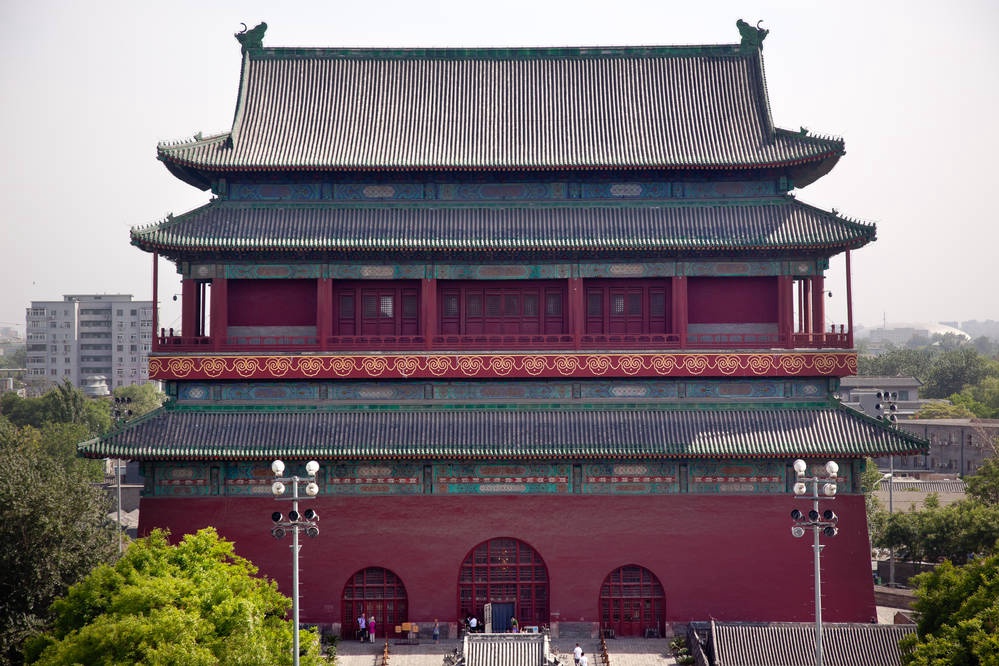Beijing's historic Zhongzhouxian, the north-south central axis, is on the application list to receive World Heritage status in 2035. Fourteen historical places along the axis, including Qianmen, the Forbidden City, Jingshan Park, Drum and Bell Towers, Chairman Mao Zedong Memorial Hall, the Monument to the People's Heroes and Tiananmen Square have been identified as key heritage sites. For foreigners who come to Beijing for the first time, the central axis is not only a classic route for traveling, but also a good choice to treat yourself with authentic Beijing flavors. Whether you are a laobeijing, which means a Beijing local, or a new comer, the following Beijing cuisines along the central axis won't let you down.
The Drum Tower

The Drum Tower, or Gulou, is situated at the northern end of the central axis to the north of Dianmen Street. Today, it is a gathering area for Beijing's independent musicians. Around Gulou, there is a small restaurant which attracted former American Vice President Joe Biden - Yaoji Fried Liver. Established in 1989, Yaoji Fried Liver is a restaurant with nearly 30 years of history. Fried pig liver, steamed buns and noodles with soybean paste are the restaurant's specialties. Along Gulou East Street, you can also see many instrument stores, live houses and record stores. Find a bar, grab a beer and listen to some live music - this is a great way to start a trip or your new life in Beijing.
Houhai
After eating the fried liver, you could take a walk to Houhai, which is located a hop, skip and a jump away from the Gulou area. Here you can taste authentic Beijing roasted meat, kaorou, as well as a famous Beijing snack - yundougao, a traditional dessert made of kidney beans with a soft and sweet taste. If you visit this area during autumn months, don't miss the sugar roasted chestnuts. Walking along the river with a bag of chestnuts is the most enjoyable way to spend a crisp autumn day in Beijing.
The Forbidden City
The Forbidden City is the former Chinese imperial palace during the Ming and Qing dynasties (1368-1911), and it now houses the Palace Museum. Eating around the area can give you the sense of being royalty. You can either enjoy the famous Peking roast duck in an ancient royal icehouse, or feast on a French afternoon tea nearby the east gate Donghuamen. Along the river, you can also find some special snacks such as the "Beijing pie" - a traditional Chinese pie with meat and vegetable stuffing.
Qianmen
Qianmen, or Zhengyangmen, is a gate along Beijing's historic city wall. The gate is situated to the south of Tiananmen Square and once guarded the southern entry into the Inner City. Today, the historic gate attracts tens of millions of visitors every year. Walking along Qianmen Street, you can find almost everything you want, from fashionable clothes, bookstores and coffee shops, to creative artifacts, and, of course, authentic Beijing flavor restaurants. For newcomers, a restaurant like Juqi is a good choice, where you can enjoy creative specialties, such as toufu in the shape of a Chinese kite and potatoes in the shape of a rabbit. There are eight hutong areas in Qianmen, and each of them has their own distinctive characteristics. Taking a stroll down these historic alleyways is always a great way to end a long day of exploring and eating your way around Beijing.
Many people who come to Beijing for the first time ask me if the food in Beijing tastes good. This is a really hard question to answer. But if you ask me where to find the authentic Beijing flavor, I suggest you travel along Beijing's central axis. Maybe next to the city wall or hidden in a hutong, a small restaurant can always surprise you. A helpful tip - if you follow the crowd, you can't go wrong!



